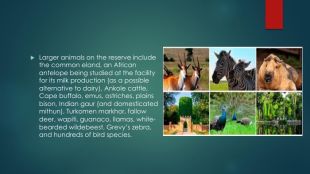Презентація Askania Nova для уроку з англфйської мови у 11 класах
Про матеріал
Презентація Askania Nova для уроку з англфйської мови у 11 класах.
Допомога вчителю на уроці. цікаві факти та новини про парк. Перегляд файлу
Зміст слайдів


Безкоштовний сертифікат
про публікацію авторської розробки
про публікацію авторської розробки
Щоб отримати, додайте розробку
Додати розробку






















